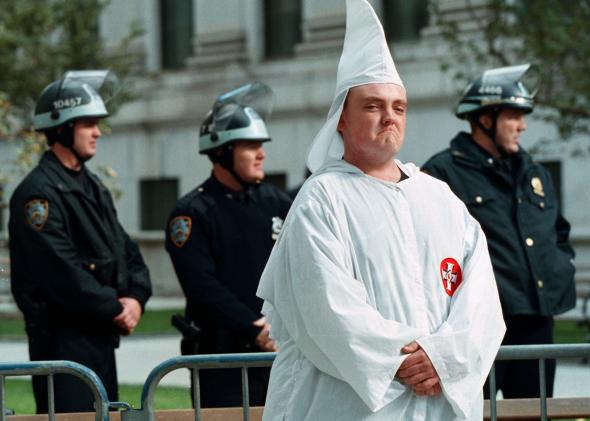The Ku Klux Klan Can’t Change Its Image, but It’s Useful to Know They’re Trying

Photo by Doug Kanter/AFP/GettyImages
Can the Ku Klux Klan rebrand?
On Sunday, CNN asked the question, apropos of the “Imperial Wizard”—Frank Ancona, leader of the Traditionalist American Knights of the Ku Klux Klan—who condemned the shooting rampage of 73-year-old Frazier Glenn Cross, a white supremacist and former Klan leader.
The internet response, and specifically Twitter, was somewhere between mockery and outrage. Here is a quick sampling:
After former KKK leader shoots up Jewish centers, CNN asks "can the Klan rebrand?" http://t.co/juODEy6R6M
--ThinkProgress (@thinkprogress) April 20, 2014CNN actually asked marketing experts whether the Ku Klux Klan could re-brand itself: http://t.co/Pg3uFJoiqZ
--Jeffrey Goldberg (@JeffreyGoldberg) April 20, 2014"Can the KKK rebrand itself?" asks CNN, in an apparent bid to rebrand itself as The Onion.
--Laila Lalami (@LailaLalami) April 20, 2014The answer, obviously, is no. After more than a century of racial terrorism, the Klan has built a sturdy reputation for itself, with a strong visual language. Anyone who sees a white, pointed hood—or a burning cross—knows exactly what it refers to.
But, as absurd as it sounds, I don’t think CNN was wrong to ask the question, nor was it out of bounds to reach out to historians and marketing experts to answer it. Yes, by broaching the topic, you run the risk of trivialization; for as much as today’s Klan is disorganized and anemic, the Klan of the early 20th century was a major American institution, with huge reach (at one point, it claimed 4 million members) and substantial political influence. In 1924, Indiana voters elected a Klansman to the governor’s mansion, and in 1926, Alabama voters sent another, Hugo Black, to the U.S. Senate, where he would serve until his nomination to the Supreme Court in 1937.
The Klan’s vigilante terror—which targeted Catholics, Jews and other ethnic whites, as well as blacks—sparked a huge backlash, which was stoked by groups like the NAACP and Anti-Defamation League, which worked to expose Klan members and activities. After reaching its peak in the middle of the 1920s, where it made strides as a seemingly innocuous fraternal organization, Klan membership declined sharply, and never recovered. The current incarnation of the Ku Klux Klan (the third, after the Reconstruction-era Klan and the 20s-era Klan) formed in response to the civil rights movement, and devoted itself to a reign of terror against civil rights workers, with bombings, murders, and assassinations.
At each point in its history, the Klan has rebranded, expanding its definition of “real” Americans to attract more members. If the KKK of the 1870s was strictly anti-black, then the KKK of the 1920s was also anti-Catholic and anti-immigrant, to attract the support of “traditional” white Americans who were indifferent to blacks, but fearful of rapid European immigration. By the 1950s and 60s, the Klan welcomed all whites in the fight for Jim Crow. Other organizations have taken a similar route. The “White Citizens Councils” of mid-century became “Councils of Conservative Citizens” in the 1980s, and more than a few white supremacists made their way into mainstream politics by way of right-wing causes and organizations.
Over the last five years, beginning with the Great Recession and the election of Barack Obama, there’s been an explosion of white supremacist groups, including new chapters of the Klan. And while some have held on to the old iconography, others have tried to broaden their appeal beyond the downscale and isolated whites they’re typically associated with. “In Pennsylvania,” observed USA Today in 2008, “the Keystone State Skinheads is changing its name to Keystone United to attract members.” Likewise, in an attempt to cast a wider net, “white nationalist” forums like Stormfront have rebranded themselves as homes for an almost-innocent “white pride.” “We are White Nationalists who support true diversity and a homeland for all peoples,” notes the welcome message at the top of the website, “Thousands of organizations promote the interests, values and heritage of non-White minorities. We promote ours.”
All of this is to say that while I understand the backlash against CNN for asking the question, I think it’s misplaced. Brands apply to more than just products, and the network did a useful service in revealing the Klan’s attempt to “rebrand,” and showing its futility. Simply put, white supremacist groups are part of the American landscape, and like most organizations, they work to recruit new members. If we can shine light on their brand management, then we can do real damage to their plans for expansion.
